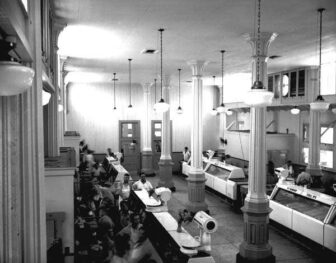Public markets were once a dominant feature of New Orleans’ commercial landscape. There were almost three dozen of them, ranging from those still well-known — the French Market and St. Roch, above all — to long-forgotten markets on Poydras, Washington, Carrollton, Ninth Street, Soraparu, Magazine, Dryades, Claiborne, Treme, St. Bernard, Port, Jefferson, Second Street, Keller, LeBreton, St. John, Ewing, Prytania, Mehle, Memory, Suburban, Rocheblave, Maestri, Delamore, McCue, Lautenschlaeger, Zengel, Guillotte, Doulluth, Behrman and Foto.
Only the French Market and the St. Roch Market are still managed by the city and a proper plan for fully rejuvenating St. Roch seems even more crucial now than in the early post-Katrina days when the neighborhoods on either side of St. Claude identified it as a significant piece of their recovery plan.
Strong neighborhood action was also vital back in the 1930s, when St. Roch was saved the first time, renovated and leased to private operators. But by the turn of the 21st century, that era at St. Roch was grinding to an end with a single lessee using only a small part of a building that by then was quite dilapidated.
This time, the city definitely needs to do better.
To his credit, Mayor Mitch Landrieu has seen the building’s post-Katrina rehab through to completion. But the true test lies ahead: whether Landrieu can achieve full occupancy in ways responsive to the interests of the diverse communities that surround the old market.

The nonprofit that serves as the city’s leasing agent for this and other properties — the New Orleans Building Corporation — has a 30-year lease to manage the property and is meant to find the “highest and best” use for the space. But what that means to the building corporation and to the neighborhoods may be vastly different. Note that the board of the building corporation is made up entirely of elected officials and mayoral appointees, but operates as a public-benefit corporation rather than under the management of a city agency. Therefore, one question remaining is whether, without direct management by a city agency, residents can maintain enough pressure to keep this project moving forward.
How can the neighborhoods assist the mayor and City Council in fully reviving St. Roch? Comment on social network sites such as Neighborland.com reveals a desire among residents to anchor the St. Roch Market with seafood, or fresh local produce — maybe even a festival-type food experience like Boston’s Haymarket or the Boqueria Market in Barcelona. These scenarios would require that the building corporation find a dozen or more entrepreneurs ready to take stalls, start selling and keep selling.
The building would also require an innovative on-site director to keep it on track. Who will that be? The most obvious candidate would be the new French Market director; he has declared providing fresh local food to be one of his goals, but, as C.W. Cannon has noted on this site, his hands are already quite full. Maybe St. Roch is where that goal can be achieved.
Here’s the challenge, however: New Orleans is having a hard time supporting all of the weekly farmers markets around town — five at last count, six if you include Gretna.
New Orleans is a city with a particular reverence for the past, yet we also adapt when necessary. The St. Roch Market project combines both of those in one project. Let’s find the right set of answers and make it work.
Of course, open-air farmers markets serve a different purpose than enclosed markets. Across the country, farmers markets have been used over the past 35 years to rebuild connections between consumers and those who grow food, usually small-scale farmers driving in from neighboring parishes and selling alongside urban cottage producers such as praline and bread makers.
Farmers markets have helped to revive heirloom foods — Creole cream cheese anyone? — and to promote seasonality. In partnership with city public health programs, they have been pioneering an increase in healthy food options for low-income residents, previously left out of the “good food” revolution.
It’s important work, but for many farmers the weekly drive to the city is a costly undertaking, as is time away from the farm. With the drive to market averaging an hour each way, to suggest that farmers can set up daily for a full 8-to-10 hours is little more than a lovely dream.
But if a daily farmers market is unlikely at St. Roch, another option that would be both welcome and feasible might be as a seafood outlet. Up front, there could be a lunch-to-late night counter for seafood platters-to-go, while inside, a seafood distributor could specialize in packaged local seafood — perhaps with a gumbo/pho counter along the back. Leave room for shared space; offer it for use by event planners and educational nonprofits. One night per week might be reserved for white-booted fishermen to set up and sell directly.
An alternative or complement to a full seafood outlet might be artisanal food and drink with room for producers to store and sell their goods directly to the public on a daily basis. The experience could be made interactive by encouraging contests, cook offs and taste testing by shoppers. Recent reports sound a lot like this idea and have neighborhood backing.
Yet another option is to focus the St. Roch Market on showcasing and selling green merchandise and educational materials — from solar systems to water-saving technology to composting gear. Whatever the theme, the important thing among the neighbors seems to be to attract local entrepreneurs, carefully selected and managed to create a coherent marketing experience.
The “white box” St. Roch is ready to accept tenants, while the construction zone snarling traffic at Claiborne and St. Bernard shows that another of the city’s venerable public market buildings, the one now known as Circle Foods, a private enterprise, remains a work in progress. If the adjacent neighborhoods want to build a complete market district, it could begin with St. Roch and, over time, mature and expand to Circle Foods, rejuvenating the St. Bernard Avenue area along the way.
The one thing I’ve noticed in my travels to public markets across the nation is that the survivors among them are good at adapting to changing community needs. The needs of New Orleans neighborhoods have changed since the 1930s. As a matter of fact, the needs expressed by the neighbors in the initial months of the post-Katrina recovery may also have changed again, what with the news that Robert’s is returning to St. Claude and the emergence of the New Orleans Food Coop directly across the street.
New Orleans is a city with a particular reverence for the past, yet we also adapt when necessary. The St. Roch Market project combines both of those in one project. Let’s find the right set of answers and make it work.
A national consultant on food and farming initiatives, Darlene Wolnik has spent the past 15 years also working alongside entrepreneurs in the New Orleans area.

